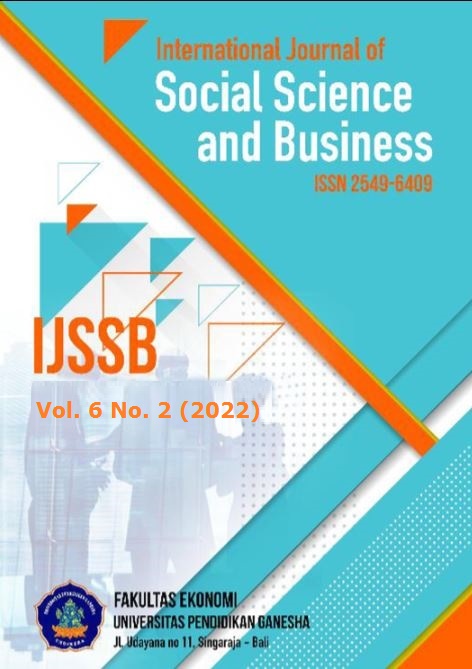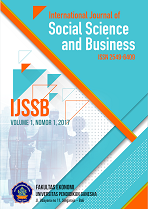Influential Factors of Online Shopping Decision
DOI:
https://doi.org/10.23887/ijssb.v6i2.44077Keywords:
consumer buying decision, online shopping, online shopping behaviorAbstract
With the technology advances, online shopping has experienced a phenomenal growth. In line with such phenomenon and its relevancy, a considerable number of studies have shown an interest within this area. Although recent researches have particularly addressed the online consumer’s behavior, findings were inconsistent. Thereby, further researches have been called for. The present study aims to investigate the effect of few variables derived from existing literature which are price, trust, promotion, easiness, service quality, and product on online consumers’ buying decision. A survey method was employed to gather data from 84 university’s students. They were recruited using purposive sampling technique in which previous online shopping experiences was required. Data were then analyzed using multiple regression. The results of data analysis showed that the six factors significantly affect consumer’s buying decision. Moreover, this study revealed that the largest contributor of these influences was price. Further discussion and managerial implications are presented.
References
Ahmed, Z., Su, L., Rafique, K., Khan, S. Z., & Jamil, S. (2017). A study on the factors affecting consumer buying behavior towards online shopping in Pakistan. Journal of Asian Business Strategy, 7(2), 44–56. https://doi.org/10.18488/journal.1006/2017.7.2/1006.2.44.56. DOI: https://doi.org/10.18488/journal.1006/2017.7.2/1006.2.44.56
Applegate, L. M., Holsapple, C. W., Kalakota, R., Radermacher, F. J., & Whinston, A. B. (1996). Electronic commerce: building blocks of new business opportunity. Journal of Organizational Computing and Electronic Commerce, 6(1), 1–10. https://doi.org/10.1080/10919399609540264. DOI: https://doi.org/10.1080/10919399609540264
Ballantine, P. W., Parsons, A., & Comeskey, K. (2015). A conceptual model of the holistic effects of atmospheric cues in fashion retailing. International Journal of Retail & Distribution Management, 43(6), 503–517. https://doi.org/10.1108/IJRDM-02-2014-0015. DOI: https://doi.org/10.1108/IJRDM-02-2014-0015
Barnes, S. J. (2020). Information management research and practice in the post-COVID-19 world. International Journal of Information Management, 55, 102175. https://doi.org/10.1016/j.ijinfomgt.2020.102175. DOI: https://doi.org/10.1016/j.ijinfomgt.2020.102175
Belanger, F., Hiller, J. S., & Smith, W. J. (2002). Trustworthiness in electronic commerce: the role of privacy, security, and site attributes. The Journal of Strategic Information Systems, 11(3–4), 245–270. https://doi.org/10.1016/S0963-8687(02)00018-5 DOI: https://doi.org/10.1016/S0963-8687(02)00018-5
Blázquez, M. (2014). Fashion shopping in multichannel retail: The role of technology in enhancing the customer experience. International Journal of Electronic Commerce, 18(4), 97–116. https://doi.org/10.2753/JEC1086-4415180404. DOI: https://doi.org/10.2753/JEC1086-4415180404
Brata, B. H., Husani, S., & Ali, H. (2017). The influence of quality products, price, promotion, and location to product purchase decision on Nitchi at PT. Jaya Swarasa Agung in Central Jakarta. Saudi Journal of Business and Management Studies, 2(4), 357–374.
Chen, Y. H., Hsu, I. C., & Lin, C. C. (2010). Website attributes that increase consumer purchase intention: A conjoint analysis. Journal of Business Research, 63(9–10), 1007–1014. https://doi.org/10.1016/j.jbusres.2009.01.023. DOI: https://doi.org/10.1016/j.jbusres.2009.01.023
Cheung, C., & Lee, M. K. (2000). Trust in Internet shopping: A proposed model and measurement instrument. AMCIS 2000 Proceedings, 406. https://aisel.aisnet.org/amcis2000/406.
Choi, K. S., Cho, S., & Lee, J. R. (2019). Impacts of online risky behaviors and cybersecurity management on cyberbullying and traditional bullying victimization among Korean youth: Application of cyber-routine activities theory with latent class analysis. Computers in Human Behavior, 100, 1–10. https://doi.org/10.1016/j.chb.2019.06.007. DOI: https://doi.org/10.1016/j.chb.2019.06.007
Christin, N. (2013). Traveling the Silk Road: A measurement analysis of a large anonymous online marketplace. Proceedings of the 22nd International Conference on World Wide Web, 213–224. https://doi.org/10.1145/2488388.2488408. DOI: https://doi.org/10.1145/2488388.2488408
Duarte, P., Silva, S. C., & Ferreira, M. B. (2018). How convenient is it? Delivering online shopping convenience to enhance customer satisfaction and encourage e-WOM. Journal of Retailing and Consumer Services, 44, 161–169. https://doi.org/10.1016/j.jretconser.2018.06.007. DOI: https://doi.org/10.1016/j.jretconser.2018.06.007
Faqih, K. M. (2016). An empirical analysis of factors predicting the behavioral intention to adopt Internet shopping technology among non-shoppers in a developing country context: Does gender matter? Journal of Retailing and Consumer Services, 30, 140–164. https://doi.org/10.1016/j.jretconser.2016.01.016. DOI: https://doi.org/10.1016/j.jretconser.2016.01.016
Gazzola, P., Pavione, E., Pezzetti, R., & Grechi, D. (2020). Trends in the fashion industry. The perception of sustainability and circular economy: A gender/generation quantitative approach. Sustainability, 12(7), 2809. https://doi.org/10.3390/su12072809. DOI: https://doi.org/10.3390/su12072809
Jiang, L. A., Yang, Z., & Jun, M. (2013). Measuring consumer perceptions of online shopping convenience. Journal of Service Management, 24(2), 191–214. https://doi.org/10.1108/09564231311323962. DOI: https://doi.org/10.1108/09564231311323962
Kuss, D. J., Griffiths, M. D., & Binder, J. F. (2013). Internet addiction in students: Prevalence and risk factors. Computers in Human Behavior, 29(3), 959–966. https://doi.org/10.1016/j.chb.2012.12.024. DOI: https://doi.org/10.1016/j.chb.2012.12.024
Lee, C. H., Eze, U. C., & Ndubisi, N. O. (2011). Analyzing key determinants of online repurchase intentions. Asia Pacific Journal of Marketing and Logistics, 23(2), 200–221. https://doi.org/10.1108/13555851111120498. DOI: https://doi.org/10.1108/13555851111120498
Lohse, G. L., Bellman, S., & Johnson, E. J. (2000). Consumer buying behavior on the Internet: Findings from panel data. Journal of Interactive Marketing, 14(1), 15–29. https://doi.org/10.1002/(SICI)1520-6653(200024)14. DOI: https://doi.org/10.1002/(SICI)1520-6653(200024)14:1<15::AID-DIR2>3.0.CO;2-C
Mehra, A., Paul, J., & Kaurav, R. P. S. (2021). Determinants of mobile apps adoption among young adults: theoretical extension and analysis. Journal of Marketing Communications, 27(5), 481–509. https://doi.org/10.1080/13527266.2020.1725780. DOI: https://doi.org/10.1080/13527266.2020.1725780
Mican, D., & Sitar-Taut, D. A. (2020). Analysis of the factors impacting the online shopping decision-making process. Studia Universitatis Babes-Bolyai, 65(1), 54–66. DOI: https://doi.org/10.2478/subboec-2020-0004
Olasanmi, O. O. (2019). Online shopping and customers’ satisfaction in Lagos State, Nigeria. American Journal of Industrial and Business Management, 9(6), 1446. https://doi.org/10.4236/ajibm.2019.96095. DOI: https://doi.org/10.4236/ajibm.2019.96095
Pavlou, P. A., & Gefen, D. (2004). Building effective online marketplaces with institution-based trust. Information Systems Research, 15(1), 37–59. https://doi.org/10.1287/isre.1040.0015. DOI: https://doi.org/10.1287/isre.1040.0015
Rahman, M. A., Islam, M. A., Esha, B. H., Sultana, N., & Chakravorty, S. (2018). Consumer buying behavior towards online shopping: An empirical study on Dhaka city, Bangladesh. Cogent Business & Management, 5(1), 1514940. https://doi.org/10.1080/23311975.2018.1514940. DOI: https://doi.org/10.1080/23311975.2018.1514940
Roggeveen, A. L., & Sethuraman, R. (2020). Customer-interfacing retail technologies in 2020 & beyond: An integrative framework and research directions. Journal of Retailing, 96(3), 299–309. https://doi.org/10.1016/j.jretai.2020.08.001. DOI: https://doi.org/10.1016/j.jretai.2020.08.001
Salih, K. O. M., Rashid, T. A., Radovanovic, D., & Bacanin, N. (2022). A comprehensive survey on the Internet of Things with the industrial marketplace. Sensors, 22(3), 730. https://doi.org/10.3390/s22030730. DOI: https://doi.org/10.3390/s22030730
Sarkar, S., & Khare, A. (2017). Moderating effect of price perception on factors affecting attitude towards online shopping. Journal of Marketing Analytics, 5(2), 68–80. https://doi.org/10.1057/s41270-017-0018-2. DOI: https://doi.org/10.1057/s41270-017-0018-2
Sudha, M., & Sheena, K. (2017). Impact of influencers in consumer decision process: the fashion industry. SCMS Journal of Indian Management, 14(3), 14–30. https://pdfs.semanticscholar.org/1469/eccb29f76b24e85cba8b6b60adf5ab4932d8.pdfm.
Turner, P. E., Johnston, E., Kebritchi, M., Evans, S., & Heflich, D. A. (2018). Influence of online computer games on the academic achievement of nontraditional undergraduate students. Cogent Education, 5(1), 1437671. https://doi.org/10.1080/2331186X.2018.1437671. DOI: https://doi.org/10.1080/2331186X.2018.1437671
Tussyadiah, I. P. (2015). An exploratory study on drivers and deterrents of collaborative consumption in travel. In Information and communication technologies in tourism 2015 (pp. 817–830). Springer. DOI: https://doi.org/10.1007/978-3-319-14343-9_59
Vrontis, D., Thrassou, A., & Melanthiou, Y. (2007). A contemporary higher education student-choice model for developed countries. Journal of Business Research, 60(9), 979–989. https://doi.org/10.1016/j.jbusres.2007.01.023. DOI: https://doi.org/10.1016/j.jbusres.2007.01.023
Downloads
Published
How to Cite
Issue
Section
License
Copyright (c) 2022 I Putu George Budiananta Merta, N. Trinanasari, I Wayan Bagia

This work is licensed under a Creative Commons Attribution-ShareAlike 4.0 International License.











